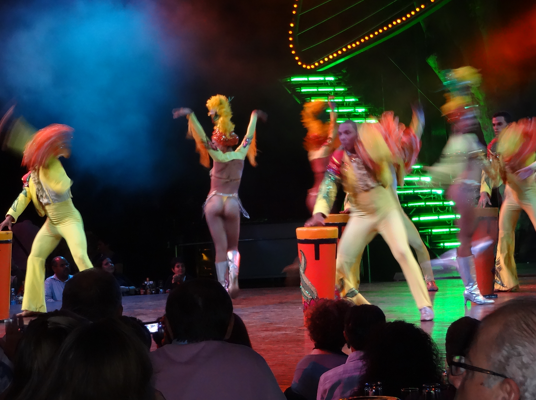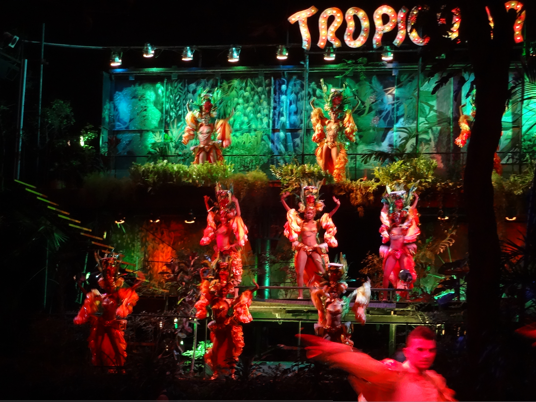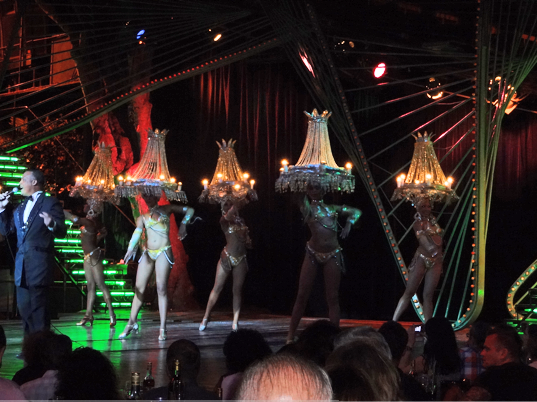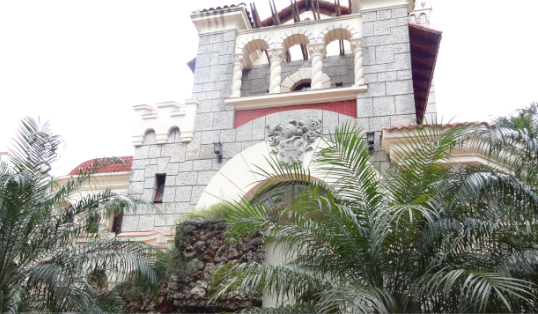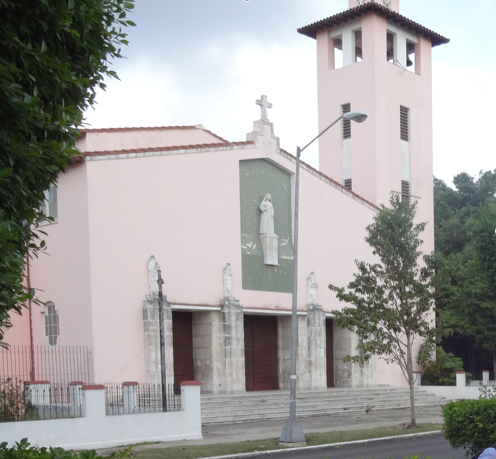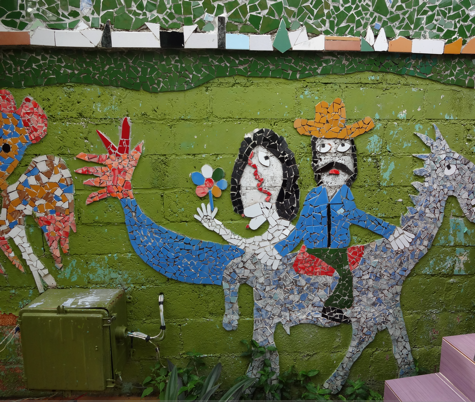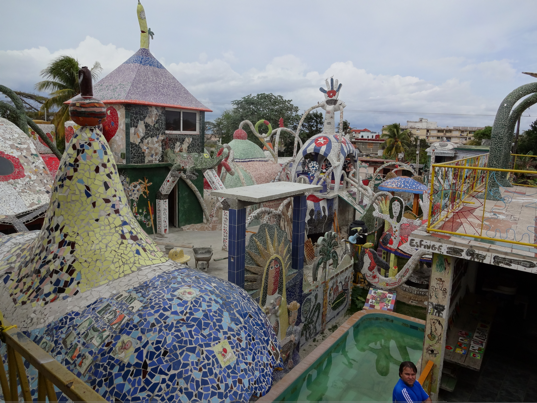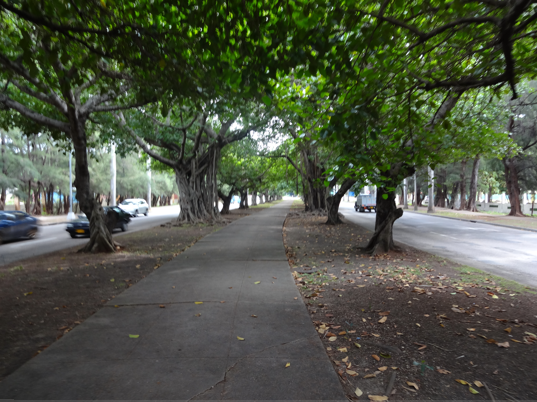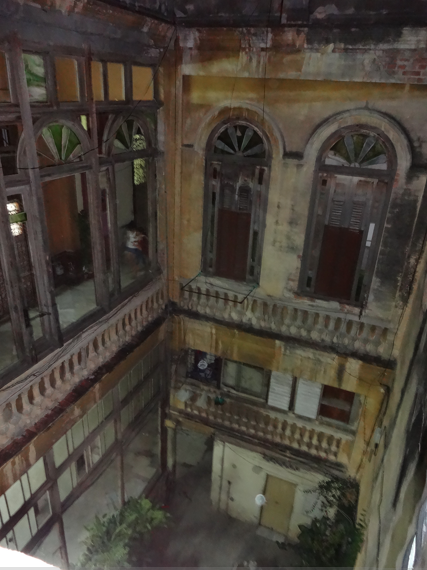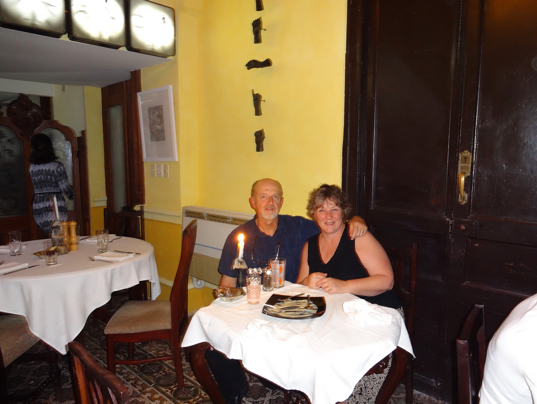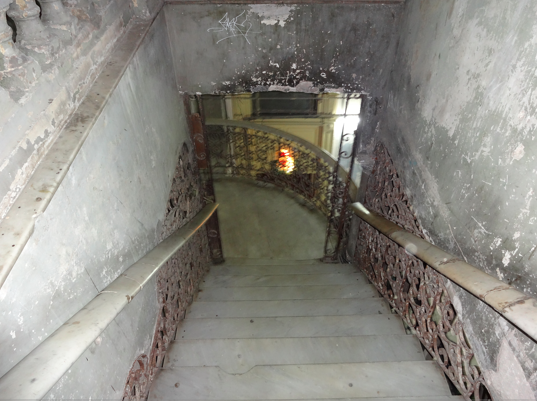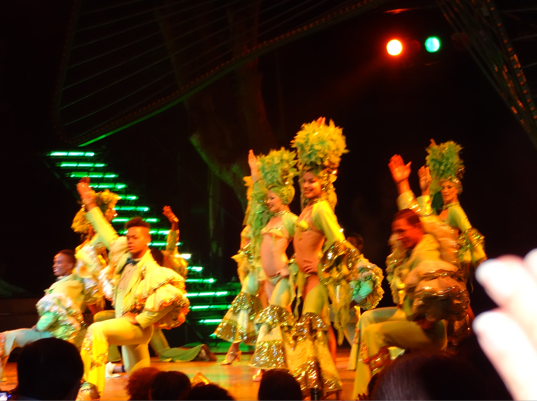We walked for breakfast to the "castle" restaurant, the actual name of which no one can remember. Afterwards, we strolled the boulevards, past St. Rita's Church where the famous Ladies in White protest the imprisonments of their relatives by attending Mass each Sunday. Although there are some Catholic churches, Santeria, a religion that intertwines aspects of Catholicism with magic and various rituals appears to be the predominant religion here.
Later, Liz, Jake and Adele stayed at the casa while Janet and I rode old local taxis toward west Havana stopping first at Hotel Melia. The guides say this is one of the places you can trust for quality cigars. Although you can buy cigars from locals on the street, we read that you might be buying rolled banana leaves or who knows what. This may be just a ploy from places like Melia (likely a state run operation) to draw tourists into their shops. One floor beneath the lobby was an elegantly appointed cigar, cigarette, and rum tienda with smoking rooms connected to the main area which also houses an on/off sale liquor bar. In the main room a woman was rolling and placing big fat cigars in ancient looking wood boxes with individual slots for forming, then compressing around 8 to 10 boxes in a large wheel-driven press. We meant to ask to snap a photo but forgot.
While there, we decided to try some high quality rum not found in los mercados. The rums in this bar were available both on and off sale and the prices for comparable bottles were almost 20% lower here than in other places we've shopped. In the mercados an average priced bottle costs 7-10 CUCs and a good quality anejo is about 15. We sampled two rums, one 15 year old bottle selling for 156 CUCs and one 25 year-old that must have been in the high 200s - we didn't ask. They were both excellent and complex. One was Ron Santiago de Cuba and the other may have been Arecha but we don't remember. Those two very high end rums we sampled, however, we're no better than Plantation rums from Barbados which sell in USA for a fraction of those prices. The cigars, on the other hand, which we sampled later, we're perhaps the best we've ever had, and we made no effort to buy the top of the line, but rather very affordable smokers.
From Melia, we taxied farther westward into the Jaimanitas neighborhood to Casa de Fuster which our friends and the guidebooks recommended highly. Janet and I always take the big old local taxis when traveling by ourselves. The Cuban taxi drivers go from one extreme to the other - 50 or 60 miles per hour down to 5 for bumps, and most drivers evidently remember the location of every bump that requires a slow crossing of which there are many.
Jose Fuster is said to be the Picasso of Cuba. His house, at about 226th street (thus about 113 blocks west of Centro) is a truly "awesome" piece of art made from millions of mosaic tiles, a project which he began after being inspired by a visit to Europe. Roofs, walls, doorways, tables, benches, everything around his studio, is covered in very small colored tiles and also there are sculptures covered in mosaic tiles of mermaids, fish, palm trees, roosters and Santeria saints, etc. There are also quotations from various Cubans and also Ernest Hemingway. With his home and yard filled with his work, more than 80 of his neighbors allowed Fuster to use their homes as his canvas, so his artwork also covers much of the surrounding neighborhood, walls, benches, street markers, everything imaginable. It is like nothing we've ever seen.
I may have unintentionally lead our taxi driver to believe we wanted him to wait in my muddled attempt to answer his questions posed in Spanish - he looked disappointed that we decided to stroll through the neighborhood instead of take his car back to the city. Wandering Fuster's neighborhood was nearly as amazing as his house. We decided to continue walking back eastward for a while along the beautiful boulevard before hailing a cab. There was a green military-style uniformed woman walking the boulevard just ahead of us, then a couple more. After a short walk we crossed over to the right side of the road to hail a taxi. We noticed more green-uniformed officials about so I forced myself to ignore my camera. Upon approaching a corner which looked like a great place to hail a taxi, we were firmly told to move on by an officer in green. To our immediate right there was a large open area of many acres, enclosed by a low wall or fence which we assumed was some kind of military complex. Then we noticed more uniformed officials and the big circle-X signs telling drivers not to stop and also signs demanding that you maintain a minimum speed. We had to walk several more blocks to find a place where we could hail a taxi.
A few days later when we asked our friend about what was going on, he said, "Oh, I forgot to tell you about that, that's Fidel's house". "All roads leading to his house are one-way streets going out", an obvious deterrent for those who might accidentally drive toward it. We also later learned that we were within a five minute walk to Marina Hemingway, which is run by the governmental Cubanacan. It is Cuba's largest marina with an official capacity of up to 400 vessels but in reality, there are only about 100 usable slips - the others are in need of repair, and installation of basic marina services like power & water.
When we returned to the casa, Liz and Jake had lunch waiting for us. Then we all walked to Copa Mercado for reprovisioning. Again, although I understood only some of the lures in rapid Spanish, I know we were congratulated for being Americans in Cuba, told of relatives in cities we know, then there were several attempts to get us to spend our money on various services and other somethings from our greeters - the police car's presence in the parking lot didn't seem to deter our grand reception and our new-found companeros' attempts at solicitation.
Later that evening, Janet and I taxied into the central city for dinner at La Guarida. In lieu of bungling the job with my marginal spanish, one of our friends had called for us and made reservations. La Guarida is in a very old building with an industrial-looking exterior, in an industrial looking neighborhood about four or five blocks off the malecon. It felt crazy pulling up in an old, worn out 1955 Dodge to a place reputed to be the best restaurant in Havana. There was a bouncer or the equivalent and his assistant outside at the street to greet us and to ask if we had reservations. The building also houses apartments so there were some Cubans just hanging about inside and out - none were begging or trying to sell us anything as were were warned. We wonder what the Cubans thought about us as we went in to eat a wonderful meal that would cost them several months wages, although a very reasonable price in USA.
The building housing La Guarida has a multi-story open-air courtyard in the center with large and beautiful, wide open, marble-looking stairways with huge arched decorative openings scattered about overlooking the floors below, but it is in a state of terrible decay and disrepair as most everything is in Havana, and as we hear, most all of Cuba. After walking up several floors, we walked through a towering narrow door into an elegant entry and followed our host to our table. We asked if we could sit at a table overlooking the city, but they were already reserved. There was interesting and beautiful artwork everywhere as if we were also in a gallery. The service and meal were excellent as was the atmosphere. In Cuba gratuity is usually added to the bill, which for Havana's finest, was very reasonable. After dinner our greeter escorted us to a taxi. We were delighted once again that it was an old, local taxi, a 1951 Plymouth. We truly love supporting the individual Cuban taxi owners.
Off to the Tropicana where someone in the embassy had made reservations for us a week earlier. The Tropicana is a huge outdoor showplace with multiple stages for dancers, singers, an orchestra, and more dancers. There are huge trees overhead and elaborate and wildly decorated sets with tropical ambience and colors. The show was well done with scantily clad performers, very active with no intermissions. Everyone got a bottle of Havana Club anejo rum, and the men got a cigar in a metal tube - can't recall the brand - while the women got a long-stemmed carnation. Never got a chance to try the cigar - left it behind in our casa. We sat across the table from a visitor from Poland on vacation from his geo-hydraulic engineering job. We had a very interesting conversation with him while the intro orchestra was playing. He had planned to rent a car, but changed his mind after witnessing the local drivers in action. We should have gotten his email address, but we left a few minutes early to beat the rush and forgot. The first available taxi was the only one of our vacation that was newer than about 1993 - we felt rather decadent and shameless.
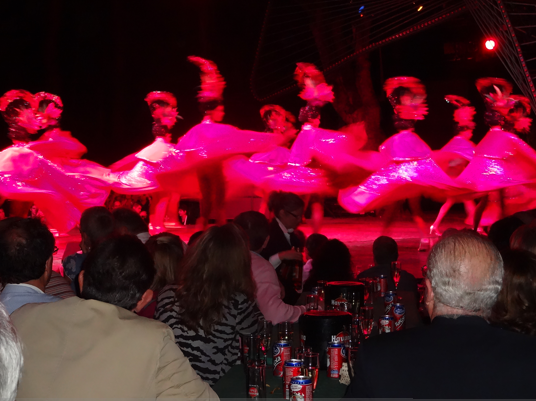
The Tropicana
